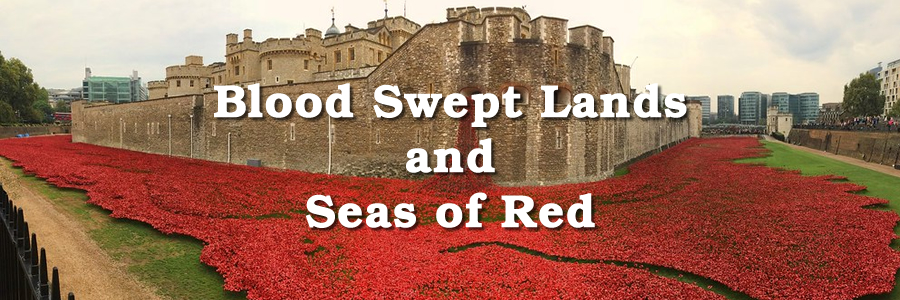Blood Swept Lands and Seas of Red was created in the moat of the Tower of London, between July and November 2014.
It commemorated the centenary of the outbreak of World War I and consisted of 888,246 ceramic red poppies, each intended to represent one British or Colonial serviceman killed in the War.
The ceramic artist was Paul Cummins, with design by the stage designer Tom Piper.
The work’s title was taken from the first line of a poem by an unknown soldier in World War I.
The Poppies were created by Paul Cummins Ceramics in conjunction with Historic Royal Palaces to be displayed in the moat of the Tower of London, which was used in the early days of the war as a training ground for City of London workers who had enlisted to fight – they were called the “Stockbrokers’ Battalion”.
The work consisted of a sea of ceramic red poppies, in a design which appeared to flow out of the Tower itself and ripple across the moat.
There were a series of designed elements which added drama, height and movement to the installation: the “Weeping Window” flowing out of a window in Legge’s Mount in the West Moat, “Over the Top”, a cascade of poppies down the wall on the wharf side of the moat and the “Wave”, a free-standing twisted metal sculpture covered in poppies which curled over the main causeway into the Tower.
The ceramic poppies were individually hand-made at Cummins’ ceramics works in Derbyshire and at Johnson Tiles in Tunstall, Stoke-on-Trent. The poppies were added to the installation progressively by volunteers.
The first poppy was “planted” on 17 July 2014, and the work was unveiled on 5 August (the day following the centenary of Britain’s entry into the war).
A team of 17,500 volunteers put the poppies in place, overseen by Tom Piper and Yeoman Warder Jim Duncan, making this a true public artwork.
The last one was planted on 11 November 2014 (Remembrance Day), by a 13-year-old cadet, Harry Hayes, from the Combined Cadet Force (CCF) of Reading Blue Coat School.
After that day a team of 8,000 volunteers started to remove the poppies. Members of the public had been able to pre-order the ceramic poppies for £25 each, with a share of the proceeds (estimated at more than £15 million) going to six service charities: COBSEO, Combat Stress, Coming Home, Help for Heroes, the Royal British Legion and SSAFA.
At around sunset each day between 1 September and 10 November, the names of 180 World War I service personnel, nominated by members of the public to appear on a Roll of Honour, were read aloud by a Yeoman Warder or guest reader, followed by the Last Post bugle call.
The installation was visited by the Princes William and Harry and the Duchess of Cambridge on the day of its opening, and by the Queen and the Duke of Edinburgh on 16 October. The Queen later spoke about the memorial in her annual Christmas Message, broadcast on 25 December 2014.
In all, an estimated 5 million people visited the installation.
The Government of the day, were asked to subsidise the event, however, they refused, and funds were raised from local businesses and the City of London.
Once the popularity of the Poppies was realised by David Cameron (Prime Minister) they wanted to ‘hijack’ the work for their own political ends. They were politely told were they ‘could go’.
The “Weeping Window” and the “Wave” went on a tour of the UK, and are now on permanent display in the Imperial War Museum, London, and the Imperial War Museum, Manchester (respectively).

